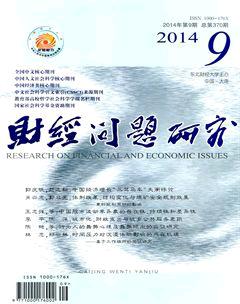多国企业集团转移定价研究
王静
摘要:本文分析了多国企业集团在垄断中间产品市场,同时最终产品市场上存在Cournot竞争对手状态下的最优转移定价策略。利用动态博弈的均衡求解方法,研究了差别定价和统一定价两种方式的最优内部转移价格。研究结果表明,最优的内部转移价格根据两国税率与进口关税之间关系的不同而有所差异,但是任何条件下企业集团采用差别定价法总是优于统一定价法。
关键词:企业集团;转移定价;Cournot竞争;边际成本
中图分类号:F202; F2240文献标识码:A
文章编号:1000176X(2014)09011405
一、引言
转移定价问题对于多国企业集团来说是一个极为重要的问题。由于不同国家之间存在税率差异,企业集团可以通过协调子公司的行为,利用转移定价策略将利润转移到低税率的国家,从而达到集团总体利润最大化的目的。根据Hansen和Janet[1]的观点,转移定价也可以看作是企业集团部分中心化的产物。部分中心化为企业集团带来众多益处,它不仅克服了集团总部信息处理能力有限的缺陷,还能缩减控制成本并为其附属公司提供激励机制。
在不考虑国家间税率差异的前提下,关于转移定价的经济分析包括Hirshleifer[2]以及Eden[3]等,他们证明了当中间产品存在不完全竞争市场时,使得集团利润最大化的最优转移价格应该等于中间产品的边际成本。慕银平等[4]分析了不对称竞争条件下企业集团的转移定价决策问题, 得出存在上游竞争的条件下, 转移价格大于边际成本; 存在下游竞争的条件下, 转移价格的大小取决于各下游企业最终产品的相互替代程度。张福利等[5]证明了中间产品转移价格取决于上游子公司和竞争子公司的不对称程度。胡荣搓和陈绍刚[6]在最终产品市场存在Stackelberg竞争情形下,对集团采用差别定价及统一定价下转移价格和最大利润进行了比较。不考虑税收差异因素的转移定价问题的最新进展参见Leng和Parlar[7]及所引用的文献。
现实中,许多企业集团在不同国家建立子公司,如福特汽车Struandale发动机厂位于南非(上游子公司),它为全球其它的福特流水线工厂(下游子公司)提供Duratorq TDCi柴油发动机,最终生产成福特皮卡敞篷小型载货卡车。因此,不同国家的税率差异必将影响集团的最终收益。此时,转移定价策略不仅可以作为附属子公司的激励机制,还可以使得集团的纳税最小化[8]。Zhao[9]考虑下游市场存在寡头竞争对手,并且在竞争为垂直一体化企业及仅生产最终产品条件下,研究了最优的转移价格策略。关于考虑税收因素的转移定价问题最新研究成果参见Rossing[10]。
本文考虑一个部分中心化的多国企业集团,集团总部控制着中间产品的定价权利,但是下游子公司具有决定最终产品产量的决策权利。在下游市场上存在一个实力相当的寡头竞争对手,但是需要集团的上游公司为其提供中间产品。在此模型框架下,研究企业集团分别采用差别定价法和统一定价法下两国税率及进口关税对最优转移价格的影响,并对两种定价法下集团的利润做比较分析。
最后,中国近二十年的高速增长的确主要依赖投资,但高经济增长主要依赖投资不一定就代表投资过度。虽然中国的资本形成率和人均实际固定资本形成增长率都明显偏高,但从人均实际固定资本形成额看,就是在被认为投资过度最明显的近十年,人均实际固定资本形成额分别仅相当于上中等收入国和高收入国人均实际固定资本形成额平均水平的2/3和1/10。就投资效率而言,有的学者研究表明,无论是从中国的总体投资回报率、工业企业资本回报率,或是从物质资本积累导致的技术进步率来看,结果都表明中国的投资效率较高;特别是从国际比较来看,中国的投资率—经济增长率之比一直大大低于其他各类样本国家的平均水平。就政府投资规模而言,虽然政府投资规模较大,但大多都属于基础设施投资。况且,今后中国无论是以技术进步促进经济结构调整和产业升级,还是以新农村建设推动城乡一体化,抑或以开发战略实现区域协调发展,都离不开一定规模的投资。
当然,我们对“三驾马车”失衡论提出质疑,并非说目前的“三驾马车”比例关系没有问题。任何事物都要一分为二地看,特别是不能全然不顾时代背景而予以否定。
正当我们为投资率偏高、消费率偏低而苦恼,千方百计要走向消费导向型经济之际,一些发达国家却在想方设法要从消费导向型经济(Consumption Led Economy)转向投资导向型经济(Investment Led Economy)。参阅Skilling[40]。在我们看来,正是过去这种“三驾马车”的“失衡”,支撑了长达三十余年的高速经济增长;换言之,在过去创新能力不足的情况下,支撑这种长期高速增长的“三驾马车”“失衡”,实质上是一种宏观动态结构性均衡,或者说这种“三驾马车”的比例关系恰与那种长期高速增长相匹配。展望未来,中国经济发展阶段进入一个新的历史时期,经济增长战略从高速增长转向中高速增长,经济增长方式从依靠劳动力、资本和自然资源的投入驱动转变到依靠知识、管理和创新驱动经济增长[41]以及社会物质财富已积累到一定程度前提下,伴随着政府公共服务水平的不断提高、居民收入日益增加以及居民消费理念和消费行为的转变,“三驾马车”的“失衡”明显改观将是一个自然的结果。参考文献:
[1]曹尔阶.我国投资饥渴症的起因及其防治[J].中央财经大学学报,1986,(1).
[2]苏挺.关于投资饥饿症理论的探讨[J].财政研究,1986,(9).
[9]胡红伟.学者建议收入增长要超GDP实际增长率提高个税起征点[N].新京报,2010-12-05.[13]Lucas, R. On the Determinants of Direct Investment: Evidence from East and South Asia[J].World Development , 1993,21(3).
[14]冼国明,严兵,张岸元.中国出口与外商在华直接投资——1983—2000年数据的计量研究[J].南开经济研究,2003,(1).
[16]Zhang, K.H.,Song,S. Promoting Exports: The Role of Inward FDI in China[J].China Economic Review, 2000,11(4).
[18]王志伟,侯艺.外商直接投资对中国出口的促进作用:2000—2008——基于贸易引力模型的分析[J].社会科学研究,2011,(6).
[21]Pack, H.Industrialisation and Trade[A].Chenery,H., Srinivasan,T.N.Handbook of Development Economics 1[C].Amsterdam:Elsevier,1988.
[26]Bahmani-Oskooee, M.,Economidou,C. Export Led Growth vs. Growth Led Exports: LDCs Experience[J].Journal of Developing Areas,2009, 42(2).
[30]Shan, J.,Sun,F.On the Export-Led Growth Hypothesis: The Econometric Evidence from China[J].Applied Economics,1998,30(8).
[31]沈程翔.中国出口导向型经济增长的实证分析:1977—1998[J].世界经济,1999,(12).
[46]Claus, I.,Haugh,D.,Scobie,G. ,Tornquist,J. Saving and Growth in an Open Economy[R].New Zealand Treasury Working Paper,No.01/32,2001.
[48]Kuijs, L.How Will Chinas Saving-Investment Balance Evolve?[R]. World Bank Policy Research Working Paper,No.3958,2006.
[52]Chamon, M.D.,Prasad,E.S.Why Are Saving Rates of Urban Households in China Rising?[J].American Economic Journal: Macroeconomics,2010,2(1).
张中华.投资饥渴症理论剖析[J].财政研究,1991,(7).
[2]罗云毅.低消费、高投资是现阶段我国经济运行的常态[J].宏观经济研究,2004,(5).
[3]樊纲.让“三驾马车”均衡前行[N].人民日报,2006-09-11.
[4]张军.中国经济还能再增长多久[J].传承,2012,(9).
[5]Ramo,J. C. The Beijing Consensus[R].The Foreign Policy Centre,2004.
[6]张宇,张晨,蔡万焕.中国经济模式的政治经济学分析[J].中国社会科学,2011,(3).
[7]孙乾,张伟摄.专家称北京居民实际收入增长率已超过经济增长[N].京华时报,2012-11-12.
[8]郭庆旺.消费函数的收入阶层假说[J].经济理论与经济管理,2013,(1).
[9]Hein,S. Trade Strategy and the Dependency Hypothesis: A Comparison of Policy, Foreign Investment, and Economic Growth in Latin America and East Asia[J]. Economic Development and Cultural Change, 1992,40(3).
[10]Bayoumi,T.,Lipworthl,G. Japanese Foreign Direct Investment and Regional Trade[J]. Journal of Asian Economics,1998,9(4).
[11]杨迤.外商直接投资对中国进出口影响的相关分析[J].世界经济,2000,(2).
[12]许和连,赖明勇.出口导向经济增长(ELG)的经验研究:综述与评论[J].世界经济,2002,(2).
[13]Giles, J.A.,Williams,C.L. Export-Led Growth: A Survey of the Empirical Literature and Some Non-Causality Results: Part 1[J].Journal of International Trade and Economic Development,2000, 9(3).
[14]Reizman, R.G.,Summers,P.M. ,Whiteman,C.H. The Engine of Growth or Its Handmaiden? A Time Series Assessment of the Exportled Growth[J].Empirical Economics, 1996,21(1).
[15]Cuadros,A.,Orts,V.,Alguacil,M.T.Re-Examining the Exportled Growth Hypothesis in Latin America:Foreign Direct Investment,Trade and Output Linkages in Developing Countries[R].European Trade Study Group Working Paper Series,2000.
[16]Kónya, L.Export-Led Growth, Growth-Driven Export, Both or None? Granger Causality Analysis on OECD Countries[J].Applied Econometrics and International Development,2004, 4(1).
[17]Shirazi,N.S. ,Manap,T.A.A.Export-Led Growth Hypothesis:Further Econometric Evidence from South Asia[J].The Developing Economics ,2005,43(4).
[18]Dreger,C.,Herzer,D.A Further Examination of the Export-Led Growth Hypothesis[J].Empirical Economics, 2013,45(1).
[19]Kwan, A. C. C.,Cotsomitis,J. A. Economic Growth and the Expanding Export Sector:China 1952—1985[J].International Economic Journal,1991,5(1).
[20]Liu, X. ,Song,H.,Romilly,P. An Empirical Investigation of the Causal Relationship between Openness and Economic Growth in China[J].Applied Economics,1997,29(12).
[21]He, D.,Zhang,W.How Dependent Is the Chinese Economy on Exports and in what Sense Has Its Growth Been Export-Led?[J]. Journal of Asian Economics ,2010,21(1).
[22]Herrerias, M.J.,Orts,V.Is the Export-Led Growth Hypothesis Enough to Account for Chinas Growth?[J]. China & World Economy, 2010,18(4) .
[23]Anderson,J. Is China Export-Led? [R].UBS Investment Research, Asian Focus,2007.
[24]Xue,J.J.The Export-Led Growth Model and Its Application in China[J].Hitotsubashi Journal of Economics ,1995,36(2).
[25]Tingvall,P.G.,Ljungwall,C.Is China Different? A Meta-Analysis of Export-Led Growth[J].Economics Letters ,2012,115(2).
[26]宋国青.全社会投资效率在上升[J].财经,2004,(10).
[27]白重恩,谢长泰,钱颖一.中国的资本回报率[M].北京:中信出版社,2007.
[28]孙文凯,肖耿,杨秀科.资本回报率对投资率的影响:中美日对比研究[J].世界经济,2010,(6).
[29]CCER“中国经济观察”研究组.我国资本回报率估测:1978—2006[J].经济学(季刊),2007,(3).
[30]梁红.中国投资的高速增长是可持续的[R].高盛全球经济研究报告系列,2006.
[31]赵志耘,吕冰洋,郭庆旺,贾俊雪.资本积累与技术进步的动态融合:中国经济增长的一个典型事实[J].经济研究,2007,(11).
[32]张军.资本形成、投资效率与中国的经济增长——实证研究[M].北京:清华大学出版社,2005.
[33]Feldstein, M.,Horioka,C.Domestic Savings and International Capital Flows[J].Economic Journal ,1980,90(358).
[34]Obstfeld, M.,Rogoff,K. The Six Major Puzzles In International Macroeconomics: Is there A Common Cause?[R].NBER Working Paper ,No.7777,2000.
[35]李扬,殷剑峰.劳动力转移过程中的高储蓄率、高投资率和中国经济增长[J].经济研究,2005,(2).
[36]Modigliani, F. ,Cao,S.L.The Chinese Saving Puzzle and the Life-Cycle Hypothesis[J].Journal of Economic Literature,2004,42(1).
[37]Horioka,C.Y.,Wan,J.The Determinants of Household Saving in China: A Dynamic Panel Analysis of Provincial Data[J].Journal of Money, Credit & Banking,2007,39(8).
[38]Ma, G. ,Yi,W. Chinas High Saving Rate: Myth and Reality[R]. Bank for International Settlements Working Paper,No.312,2010.
[39]Solow, R. M. Technical Change and the Aggregate Production Function[J].The Review of Economics and Statistics,1957,39(3).
[40]Skilling, D. Home Is where the Money Is: The Economic Importance of Savings[R].The New Zealand Institute Discussion Paper, No.1,2005.
[41]赖德胜.使改革红利更好地惠及全体人民[J].北京工商大学学报(社会科学版),2014,(1).
The Paradox of the Troika Imbalance for Chinese Economic Growth
Guo Qingwang
China Financial Policy Research Center and School of Finance, Renmin University of China,100872
Abstract:China has maintained rapid economic growth over the past three decades,which attracts attentions from the world. In the mean time, the imbalance among the troika for economic growth, investment, consumption and net exports, has also been criticized. Noticing the stage of social and economic development in China and using annual data from 1970 to 2010 for a panel of 112 economies, this paper shows that Chinas consumption demand is not weak, economic growth is not export-oriented. We also show that although the rapid economic growth over the recent 20 years in China is mainly driven by investment, it is not necessarily indicating excessive investment. Our findings also imply that, the troika imbalance supporting Chinese long-term high growth, is essentially a macro dynamic structural equilibrium. Looking to the future, with the entering to a new historical period of China's economic development stage, particularly under the economic growth strategy of moderating growth rate and switching to innovation-driven growth, the troika imbalance will be improved significantly.
Key words:Rapid Economic Growth;the Troika Imbalance;International Comparative Analysis
(责任编辑:刘艳)
[38]Ma, G. ,Yi,W. Chinas High Saving Rate: Myth and Reality[R]. Bank for International Settlements Working Paper,No.312,2010.
[39]Solow, R. M. Technical Change and the Aggregate Production Function[J].The Review of Economics and Statistics,1957,39(3).
[40]Skilling, D. Home Is where the Money Is: The Economic Importance of Savings[R].The New Zealand Institute Discussion Paper, No.1,2005.
[41]赖德胜.使改革红利更好地惠及全体人民[J].北京工商大学学报(社会科学版),2014,(1).
The Paradox of the Troika Imbalance for Chinese Economic Growth
Guo Qingwang
China Financial Policy Research Center and School of Finance, Renmin University of China,100872
Abstract:China has maintained rapid economic growth over the past three decades,which attracts attentions from the world. In the mean time, the imbalance among the troika for economic growth, investment, consumption and net exports, has also been criticized. Noticing the stage of social and economic development in China and using annual data from 1970 to 2010 for a panel of 112 economies, this paper shows that Chinas consumption demand is not weak, economic growth is not export-oriented. We also show that although the rapid economic growth over the recent 20 years in China is mainly driven by investment, it is not necessarily indicating excessive investment. Our findings also imply that, the troika imbalance supporting Chinese long-term high growth, is essentially a macro dynamic structural equilibrium. Looking to the future, with the entering to a new historical period of China's economic development stage, particularly under the economic growth strategy of moderating growth rate and switching to innovation-driven growth, the troika imbalance will be improved significantly.
Key words:Rapid Economic Growth;the Troika Imbalance;International Comparative Analysis
(责任编辑:刘艳)

